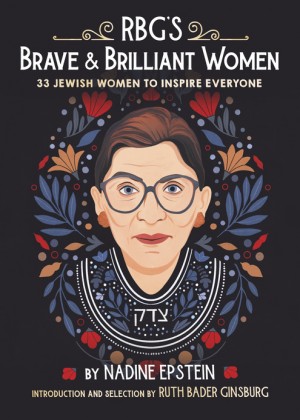Appointed by President Clinton in 1993 as the second woman to serve as a Supreme Court justice, Ruth Bader Ginsburg emerged as a fearless advocate for the legal rights of women, people of color, and other marginalized communities. RBG’s career has been governed by her dedication to the United States Constitution and her belief in universal human rights. Debbie Levy and Whitney Gardner’s outstanding graphic biography, Becoming RBG, tells the story of RBG’s personal and professional life. From inspiration to opposition, RBG moved forward with an with an unfailing conviction in her own ability to effect incremental change.
One of the book’s outstanding features is Levy’s insight into the way in which young RBG analyzes her surroundings and chooses to engage with challenges. Gardner’s color palette underscore the earlier era of the book’s events. During RBG’s childhood and beyond, she identifies with powerful women and asserts her right to determine her own place. When a teacher attempts to force left-handed RBGinto writing with her right hand, she moves from frustration, to consideration of the problem, to a solution. Later in her career, she will subvert gender roles — which she finds just as irrational as limiting the use of her left hand. Arguing against discriminatory structures which deny women full participation in American life, RBG finds strength in a tradition of women’s defiance in the face of men’s objections. Gardner visualizes her as a strong young woman surrounded by obtuse and sexist judicial quotes about women’s weaknesses.
Throughout the book, Levy emphasizes the interconnected impact of RBG’s Jewish and American values on her moral foundation. Readers familiar with the Holocaust will learn how Jewish Americans, many the children or grandchildren of immigrants, were wrenched from a sense of security by learning of the Nazi terror. A map of Hitler’s assault and images of his victims are compelling elements in the story, as is Levy’s clear assertion that, while many other groups suffered the effects of his hatred, “the defining tenet of Nazism was anti-Semitism — that is, hatred of Jews.” Just as compelling is her revelation that many Americans, including two “grandmotherly ladies” on RBG’s block, were actively inculcating hatred of Jews as “Christ killers” into the foster children in their care. Gardner’s picture of the women, with boys seated on their laps like ventriloquist’s dummies, conveys how impressionable children are. Suffering is not the definitive aspect of RBG’s Jewish education as she excels in Hebrew school and writes for her synagogue’s newsletter, always keeping Jewish values of courage and fairness at the center of her activism. When her mother dies, Levy records RBG’s anger at her exclusion from the mourner’s minyan because she is a woman.
There are many crucial relationships which guide RBG’s life including her loving partnership with her husband Marty, a man who believed in women’s equality in the workplace as well as the need for men’s equal participation in raising a family. RBG’s integration of her mother’s lessons into every decision she makes and her grief at her mother’s early death are constant motifs in Becoming RBG. Gardner shows RBG at her mother’s knee, with a cloud-shaped bubble enclosing a summary of the First Lady’s ideals: “Don’t be prejudiced. Be open to refugees who come to our country. Don’t be cruel, even to enemies.” Levy notes the poignant definition of femininity which Celia Bader communicates, which includes both financial independence and avoidance of jealousy and anger. RBG would transform this advice into a roadmap for change through a calm and measured insistence that justice for all is a basic human right.
Becoming RBG is highly recommended. The book’s detailed backmatter includes an epilogue, a timeline, a bibliography, and the sources for the included quotations.
Emily Schneider writes about literature, feminism, and culture for Tablet, The Forward, The Horn Book, and other publications, and writes about children’s books on her blog. She has a Ph.D. in Romance Languages and Literatures.



